Numerical Analysis of Factors Influencing the Ground Surface Settlement above a Cavity
Abstract
1. Introduction
2. Materials and Methods
2.1. Verification of the Numerical Analysis Method
2.2. Numerical Analysis Considering the Factors Influencing Cavity Occurrence
3. Results and Discussion
3.1. Vertical Displacement Distribution
3.2. Correlations between Cavity Type and Area and Surface Settlement
3.3. Correlations between Pavement Thickness, Elastic Modulus, and Surface Settlement
4. Conclusions
- (1)
- The results of the vertical displacement distribution showed that the largest amount of surface settlement occurred at the top of the model ground center. The vertical displacement decreased as the distance from the model ground center increased. This means that the effect of stress release and load was the greatest at the center of the model ground, and the effect became smaller farther from the center. For the rectangular cavity, it was qualitatively confirmed that the vertical displacement occurring in the ground element above the cavity was relatively larger than for a circular cavity. Therefore, it was found that the behavior of the ground around the cavity could be qualitatively evaluated from the results of the vertical displacement distribution.
- (2)
- When the elastic modulus was 3000 MPa under the condition of the smallest thickness of the pavement layer, the surface settlement of rectangular and circular cavities increased by 51% to 150% and by 36% to 91%, respectively, with the increase of the cavity size. This trend of increased surface settlement was the same even when the elastic modulus was 1000 MPa and 500 MPa. This means that the surface settlement increased as the cavity size increased, and the circular cavity was more stable than the rectangular cavity.
- (3)
- When the cavity size was the largest under the condition of the smallest thickness of the pavement, the surface settlement of the rectangular and circular cavities decreased by 30% to 42% and by 18% to 29%, respectively, with the increase of the cavity thickness. The surface settlement decreased as the elastic modulus decreased.
- (4)
- Based on the FEA results, the mechanical behavior of ground around a cavity was successfully evaluated considering influencing factors such as cavity type and area, traffic load, pavement thickness, and elastic modulus. Furthermore, the degree of stability decrease underground where a cavity occurred could be evaluated through the correlations between each influencing factor and surface settlement. However, the stability should be quantitatively evaluated, and predictive indicators should be suggested in future work considering more variable analysis conditions. It is also necessary to study other conditions of the ground, because this study reports the numerical analysis results of limited conditions.
Author Contributions
Funding
Institutional Review Board Statement
Informed Consent Statement
Data Availability Statement
Conflicts of Interest
References
- MOLIT (Ministry of Land, Infrastructure, and Transport), Special Act on Underground Safety Management. Available online: https://www.law.go.kr/LSW/lsInfoP.do?lsiSeq=179313&efYd=20180101#0000 (accessed on 22 August 2022).
- Oh, D.; Kong, S.; Lee, D.; Yoo, Y.; Lee, Y. Effects of Reinforced Pseudo-Plastic Backfill on the Behavior of Ground around Cavity Developed due to Sewer Leakage. J. Korean Geo-Environ. Soc. 2015, 16, 13–22. [Google Scholar] [CrossRef][Green Version]
- Kim, S.L. Basic Study on Cave-in Road through Model Chamber Tests. Master’s Thesis, Dong-eui University, Busan, Republic of Korea, 2017. [Google Scholar]
- You, S.K.; Kim, J.B.; Han, J.G.; Hong, G.G.; Yun, J.M.; Lee, K.I. A Study on Simulation of Cavity and Relaxation Zone Using Finite Element Method. J. Korean Geosynth. Soc. 2017, 16, 67–74. [Google Scholar]
- You, S.K.; Ahn, H.C.; Kim, Y.H.; Han, J.G.; Hong, G.G.; Park, J.J. A Numerical Study on the Occurrence Scope of Underground Cavity and Relaxation Zone Considering Sewerage Damage Width and Soil Depth. J. Korean Geotech. Soc. 2019, 35, 43–53. [Google Scholar]
- Choi, S.I.; Kweon, G.C. Characteristics of Road Subsidence Caused by Damaged Water and Sewer Pipes. Int. J. Highw. Eng. 2019, 21, 9–16. [Google Scholar]
- Ahn, H.C. Analysis of Ground Cavity Occurrence Characteristics and Ground Stability Using Numerical Analysis. Master’s Thesis, Chung-Ang University, Seoul, Republic of Korea, 2020. [Google Scholar]
- Ali, H.; Choi, J. Risk Prediction of Sinkhole Occurrence for Different Subsurface Soil Profiles due to Leakage from Underground Sewer and Water Pipelines. Sustainability 2020, 12, 310. [Google Scholar] [CrossRef]
- Seol, Y.M. Field Applicability Assessment of Controlled Low Strength Materials Using Paper Ash. Ph.D. Thesis, Chung-Ang University, Seoul, Republic of Korea, 2022. [Google Scholar]
- MOLIT (Ministry of Land, Infrastructure, and Transport), We will Create a Safe Land without Subsidence. Available online: http://www.molit.go.kr/USR/NEWS/m_71/dtl.jsp?id=95082734 (accessed on 22 August 2022).
- Kim, Y.H. Cavity Design Guidelines Considering Cavity Expansion and Ground Stability. Ph.D. Thesis, Chung-Ang University, Seoul, Republic of Korea, 2022. [Google Scholar]
- Tharp, T.M. Mechanics of upward propagation of cover-collapse sinkholes. Eng. Geol. 1999, 52, 23–33. [Google Scholar] [CrossRef]
- Sato, M.; Kuwano, R. Model Tests for the Evaluation of Formation and Expansion of a Cavity in the Ground. In Proceedings of the 7th International Conference on Physical Modelling in Geotechnics, Zurich, Switzerland, 28 June–1 July 2010. [Google Scholar]
- Kuwano, R.; Sato, M.; Sera, R. Study on the detection of underground cavity and ground loosening for the prevention of ground cave-in accident. Jpn. Geotech. J. 2010, 5, 219–229. [Google Scholar] [CrossRef][Green Version]
- Renuka, S.; Kuwano, R. Formation and Evaluation of Loosened Ground above a Cavity by Laboratory Model Test with Uniform Sand. In Proceedings of the 13th International Summer Symposium, Uji, Japan, 26 August 2011. [Google Scholar]
- Mukunoki, T.; Kumano, N.; Otani, J. Image analysis of soil failure on defective underground pipe due to cyclic water supply and drainage using X-ray CT. Front. Struct. Civ. Eng. 2012, 6, 85–100. [Google Scholar] [CrossRef]
- Oh, S.J. Laboratory Model Test for Identification of a Rear Cavity Occurrence Mechanism at Sewage pipe in Sandy Ground. Master’s Thesis, Chon-nam National University, Gwangju, Republic of Korea, 2016. [Google Scholar]
- Karoui, T.; Jeong, S.Y.; Jeong, Y.H.; Kim, D.S. Experimental Study of Ground Subsidence Mechanism Caused by Sewer Pipe Cracks. Appl. Sci. 2018, 8, 679. [Google Scholar] [CrossRef]
- Jeong, H.J. Analysis of Ground Subsidence Characteristics by Influence Factor through Laboratory Model Test. Ph.D. Thesis, Chonnam National University, Gwangju, Republic of Korea, 2018. [Google Scholar]
- Rahmati, O.; Fatemeh, F.; Seyed, A.N.; Trent, B.; Milad, S.; Ravinesh, C.D.; Artemi, C.; Farnoush, M.; Dieu, T.B. Land subsidence modelling using tree-based machine learning algorithms. Sci. Total Environ. 2019, 672, 239–252. [Google Scholar] [CrossRef]
- Kim, H.Y. An Experimental Study on the Detection of Loosened zone Underground Cavity. Master’s Thesis, Chung-Ang University, Seoul, Republic of Korea, 2020. [Google Scholar]
- Arabameri, A.; Lee, S.; Rezaie, F.; Chandra, S.P.; Asadi Nalivan, O.; Saha, A.; Chowdhuri, I.; Moayedi, H. Performance Evaluation of GIS-Based Novel Ensemble Approaches for Land Subsidence Susceptibility Mapping. Front. Earth Sci. 2021, 9, 307. [Google Scholar] [CrossRef]
- Sardooi, E.R.; Pourghasemi, H.R.; Azareh, A.; Sardoo, F.S.; John, J.C. Comparison of statistical and machine learning approaches in land subsidence modelling. Geocarto Int. 2022, 37, 6165–6185. [Google Scholar] [CrossRef]
- Drumm, E.C.; Aktürk, Ö.; Akgün, H.; Tutluoğlu, L. Stability charts for the collapse of residual soil in karst. J. Geotech. Geoenviron. Eng. 2009, 135, 925–931. [Google Scholar] [CrossRef]
- Suchowerska, A.M.; Merifield, R.S.; Carter, J.P.; Clausen, J. Prediction of underground cavity roof collapse using the hoek-brown failure criterion. Comput. Geotech. 2012, 44, 325–342. [Google Scholar] [CrossRef]
- Kim, J.B.; You, S.K.; Han, J.G.; Hong, G.G.; Park, J.B. A Study on Simulation of Cavity and Relaxation Zone Using Laboratory Model Test and Discrete Element Method. J. Korean Geosynth. Soc. 2017, 16, 11–21. [Google Scholar]
- Lee, K.C.; Park, J.H.; Choi, B.H.; Kim, D.W. Analysis of Influencing Factors on Cavity Collapse and Evaluation of the Existing Cavity Management System. J. Korean Geosynth. Soc. 2018, 17, 45–54. [Google Scholar]
- An, J.S.; Kang, K.N.; Song, K.I.; Kim, W.S.; Kim, B.C. A numerical study on the 3-Dimensional shape characteristics of small underground cavities. J. Korean Tunn. Undergr. Space Assoc. 2018, 20, 787–807. [Google Scholar]
- Choi, Y.W. A Study on the Characteristics of Cave-in and Its Risk Assessment in Urban Road. Ph.D. Thesis, Sejong University, Seoul, Republic of Korea, 2018. [Google Scholar]
- You, S.K.; Ahn, H.C.; Kim, Y.H.; Han, J.G.; Hong, G.G.; Park, J.J. A Numerical Analysis on Stability Analysis of Cavity Ground considering Pavement Thickness and Traffic Load. J. Korean Geosynth. Soc. 2019, 18, 287–297. [Google Scholar]
- Ham, M.S.; Park, S.W.; Lee, H.D. A Study on Estimation of the Collapse Pattern of Road Sink Using Distinct Element Method. J. Korean Soc Disaster Secur. 2019, 12, 57–63. [Google Scholar]
- Park, H.M.; Choi, Y.W. Evaluation of Structural Capacity of Asphalt Pavement in Subsurface Cavity Sections using Falling Weight Deflectometer Backcalculation Method. Int. J. Highw. Eng. 2019, 21, 19–25. [Google Scholar] [CrossRef]
- Vennari, C.; Parise, M. A Chronological Database about Natural and Anthropogenic Sinkholes in Italy. Geosciences 2022, 12, 200. [Google Scholar] [CrossRef]
- Lin, M.L.; Jeng, F.S.; Tsai, L.S.; Huang, T.H. Wetting weakening of tertiary sandstones—Microscopic mechanism. Environ. Geol. 2005, 48, 265–275. [Google Scholar] [CrossRef]
- Bérest, P. Cases, causes and classifications of craters above salt caverns. Int. J. Rock Mech. Min. Sci. 2017, 100, 318–329. [Google Scholar] [CrossRef]
- Castellanza, R.; Lollino, P.; Ciantia, M. A methodological approach to assess the hazard of underground cavities subjected to environmental weathering. Tunn. Undergr. Space Technol. 2018, 82, 278–292. [Google Scholar] [CrossRef]
- Fu, J.; Safaei, M.R.; Haeri, H.; Sarfarazi, V.; Fatehi Marji, M.; Xu, L.; Arefnia, A. Experimental Investigation on Deformation Behavior of Circular Underground Opening in Hard Soil using a 3D Physical Model. J. Min. Environ. 2022, 13, 727–749. [Google Scholar]
- Sarfarazi, V.; Asgari, K. Influence of Single Tunnel and Twin Tunnel on Collapse Pattern and Maximum Ground Movement. J. Min. Environ. 2022, 13, 117–128. [Google Scholar]
- Schanz, T.; Verrmeer, P.A.; Bonnier, P.G. The Hardening Soil Model: Formulation and Verification. In Beyond 2000 in Computational Geotechnics; Routledge: London, UK, 1999. [Google Scholar]
- PLAXIS “Material Models Manual”; Bentley: Exton, PA, USA, 2016; pp. 65–91.
- Benz, T. Small-Strain Stiffness of Soils and its Numerical Consequences. Ph.D. Thesis, University of Stuttgart, Stuttgart, Germany, 2007. [Google Scholar]

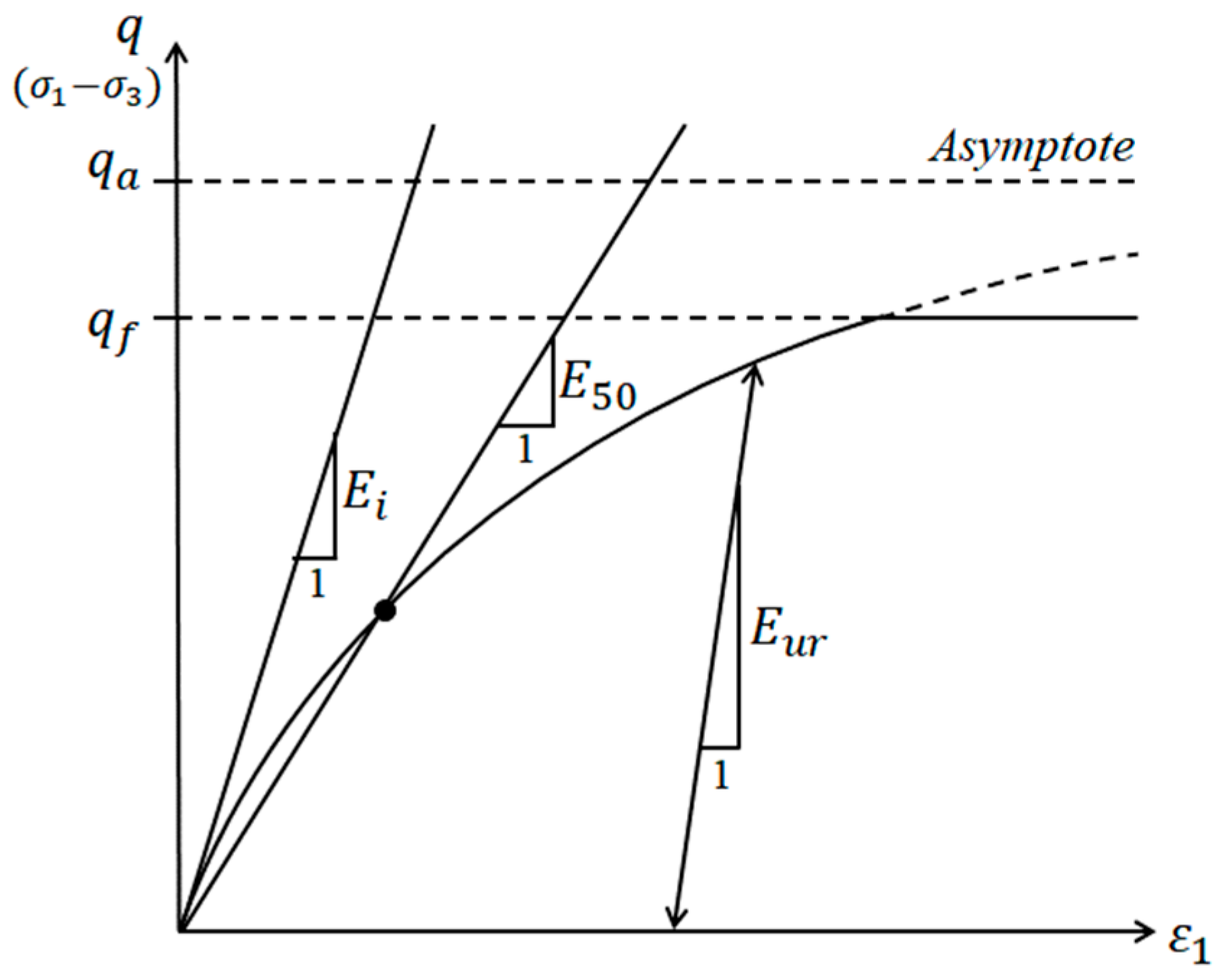
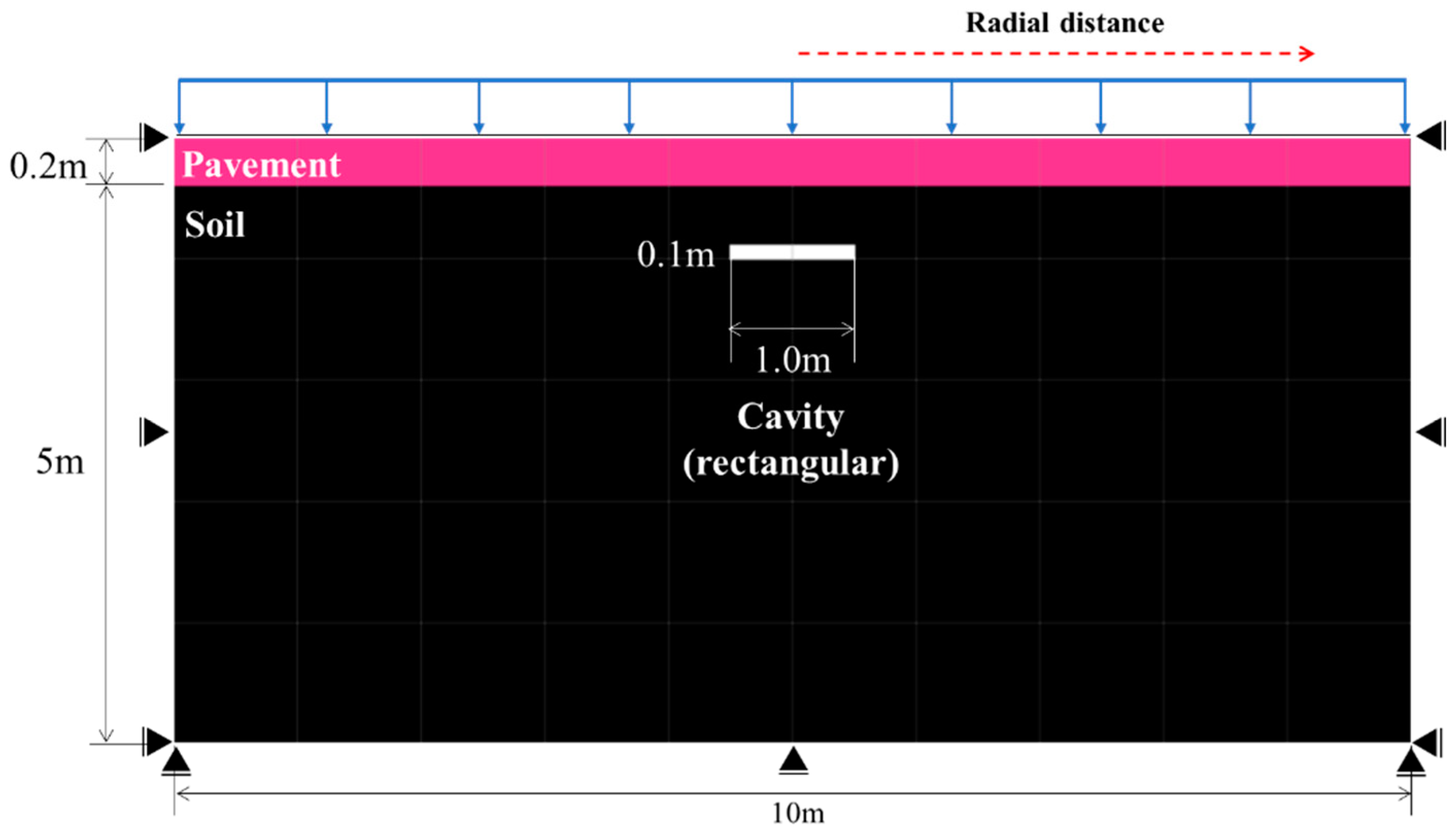
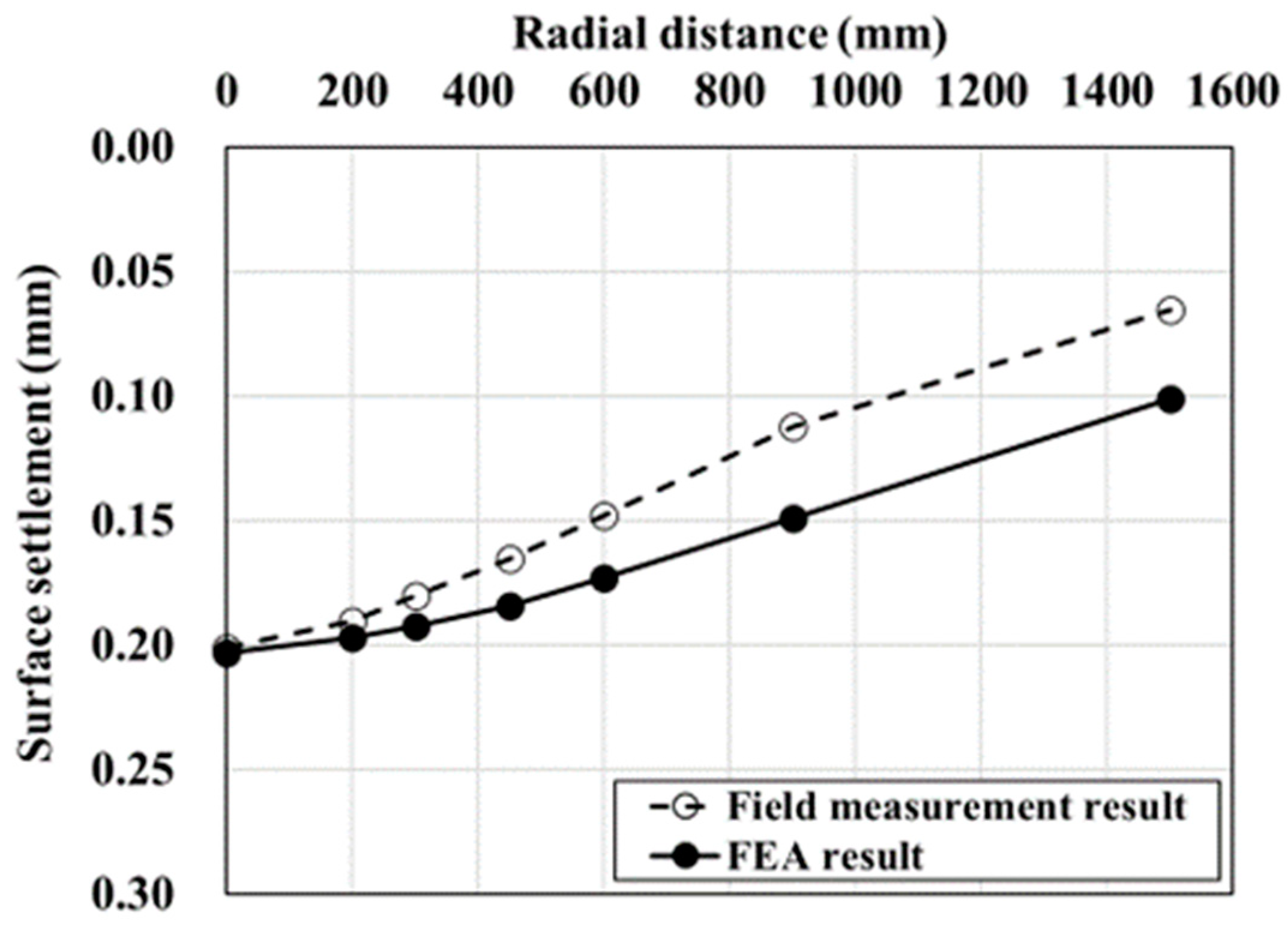
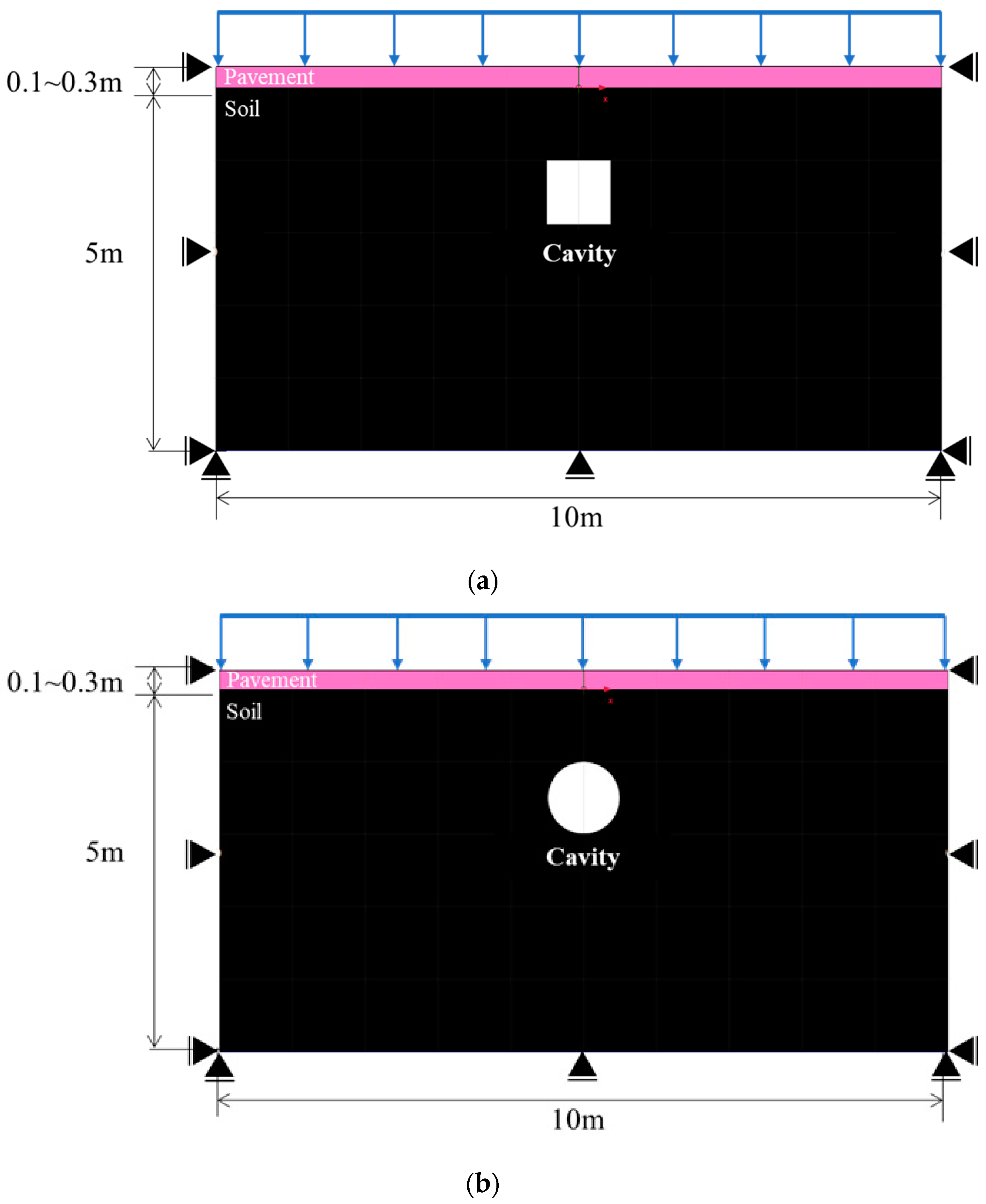
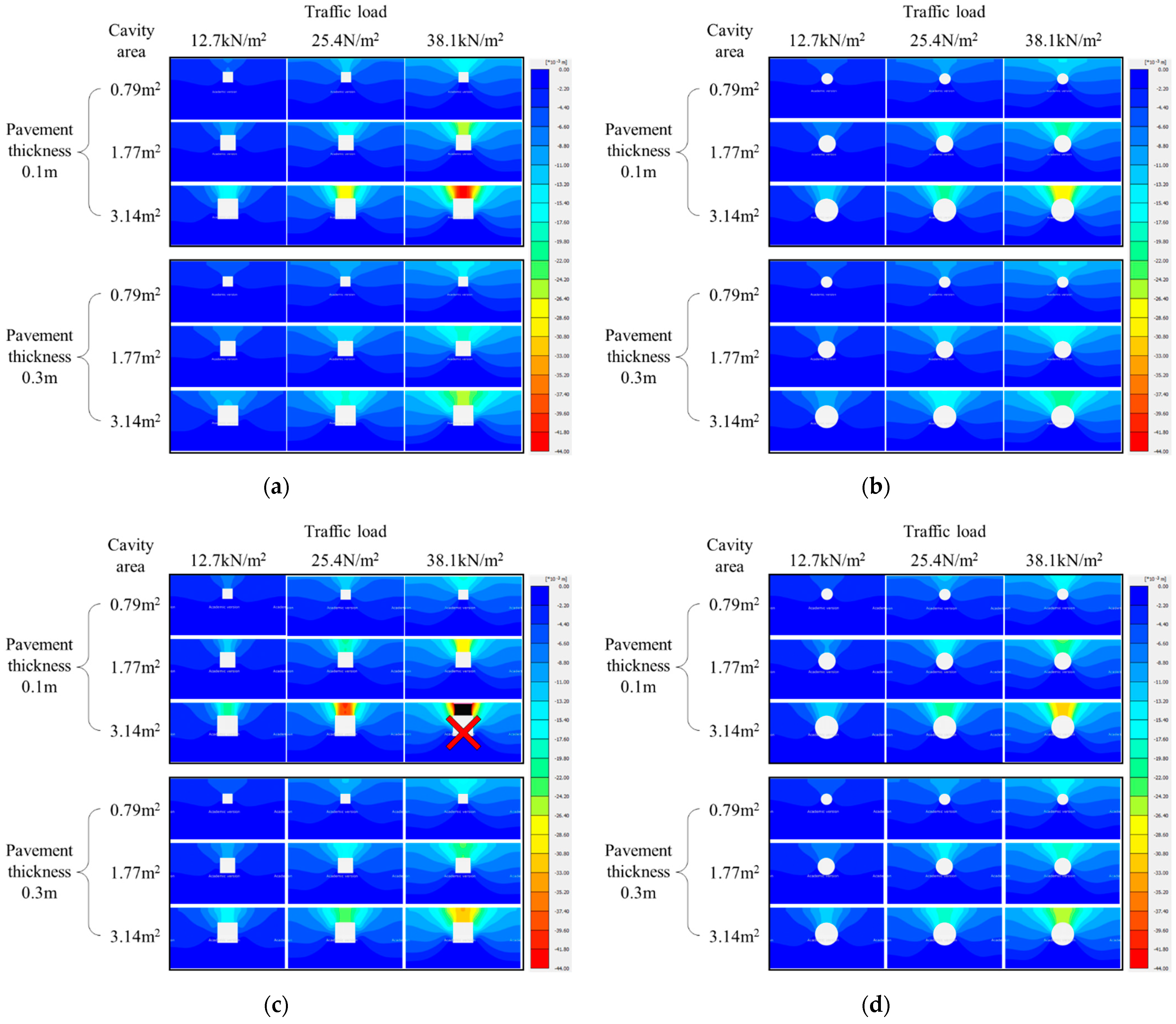
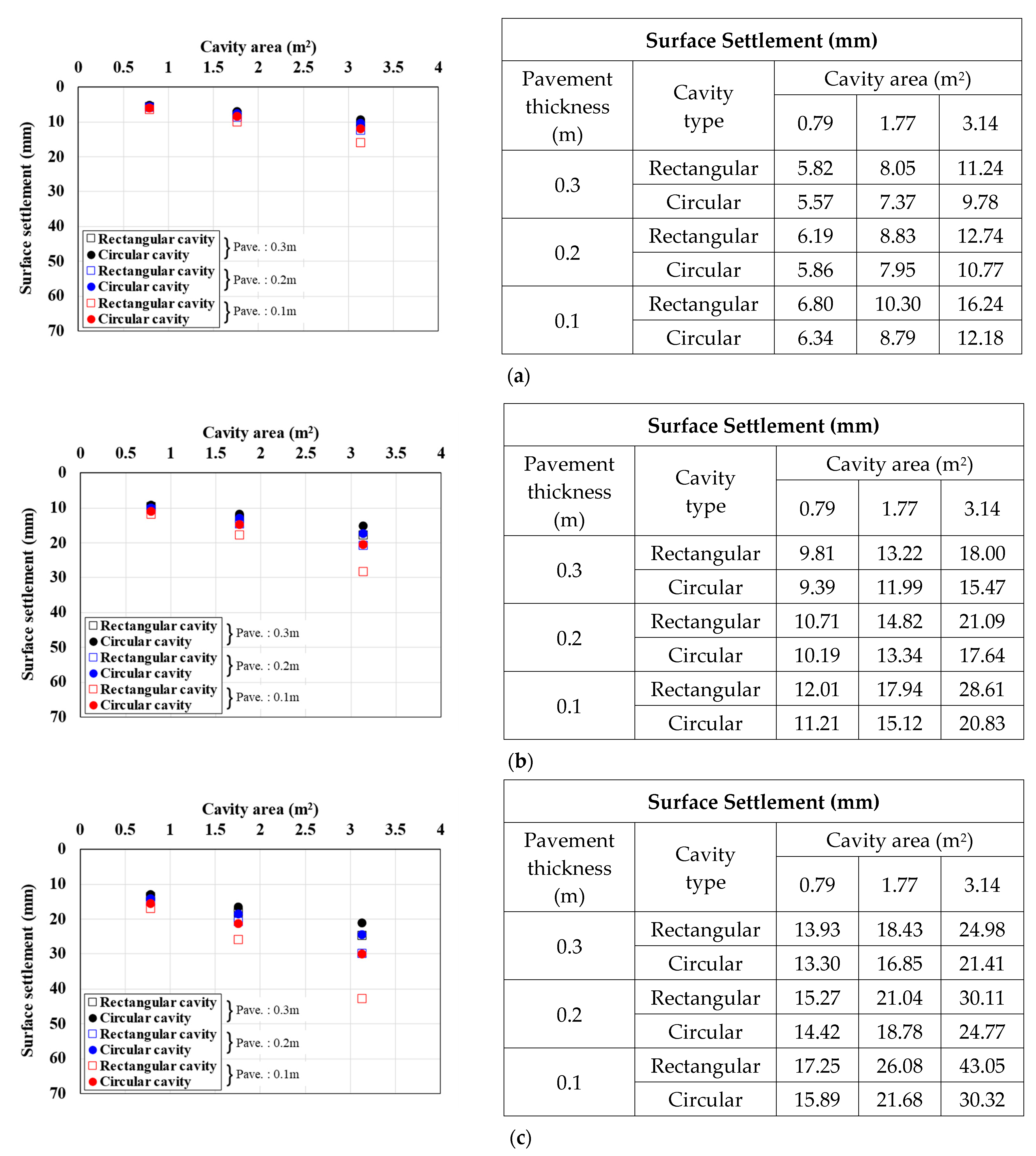
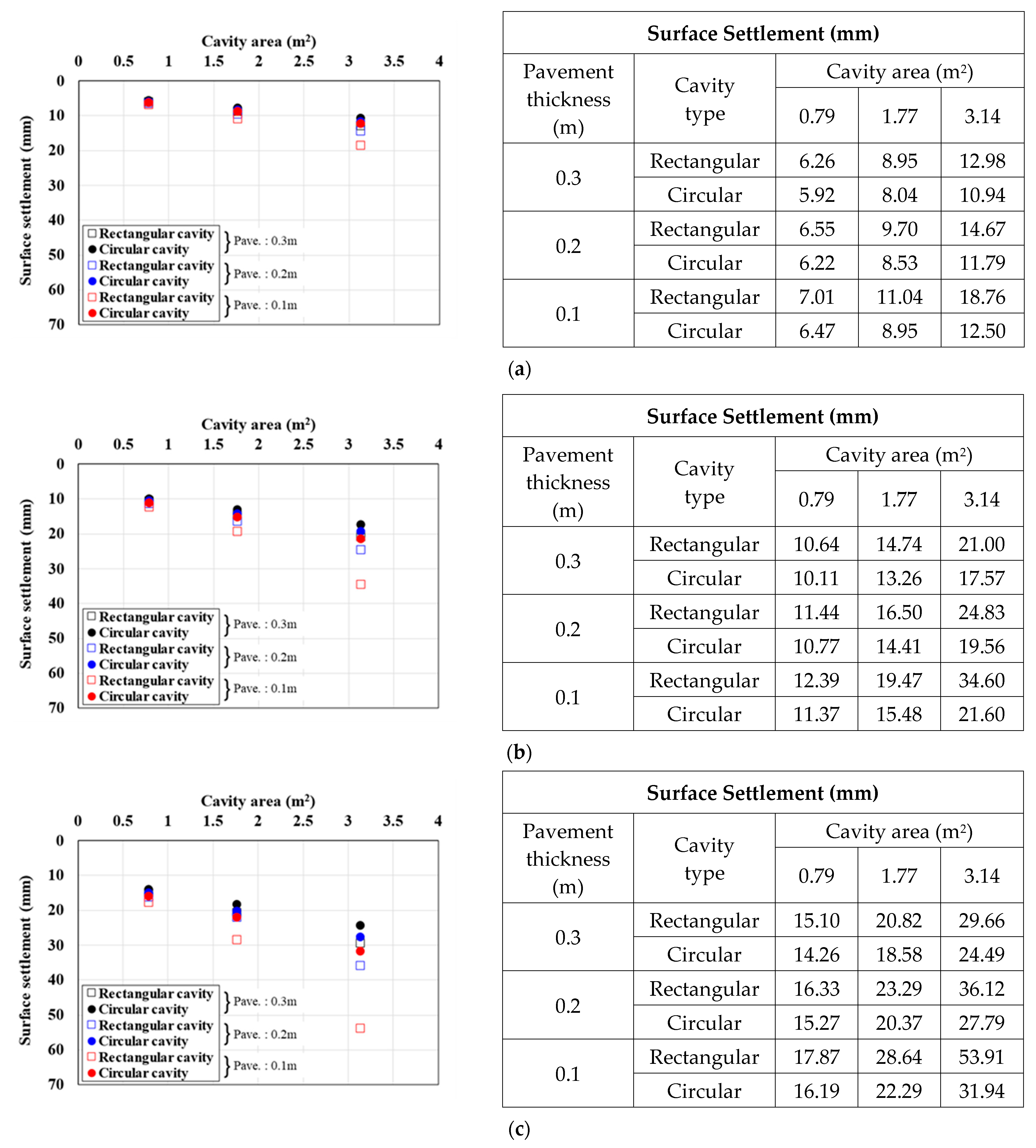
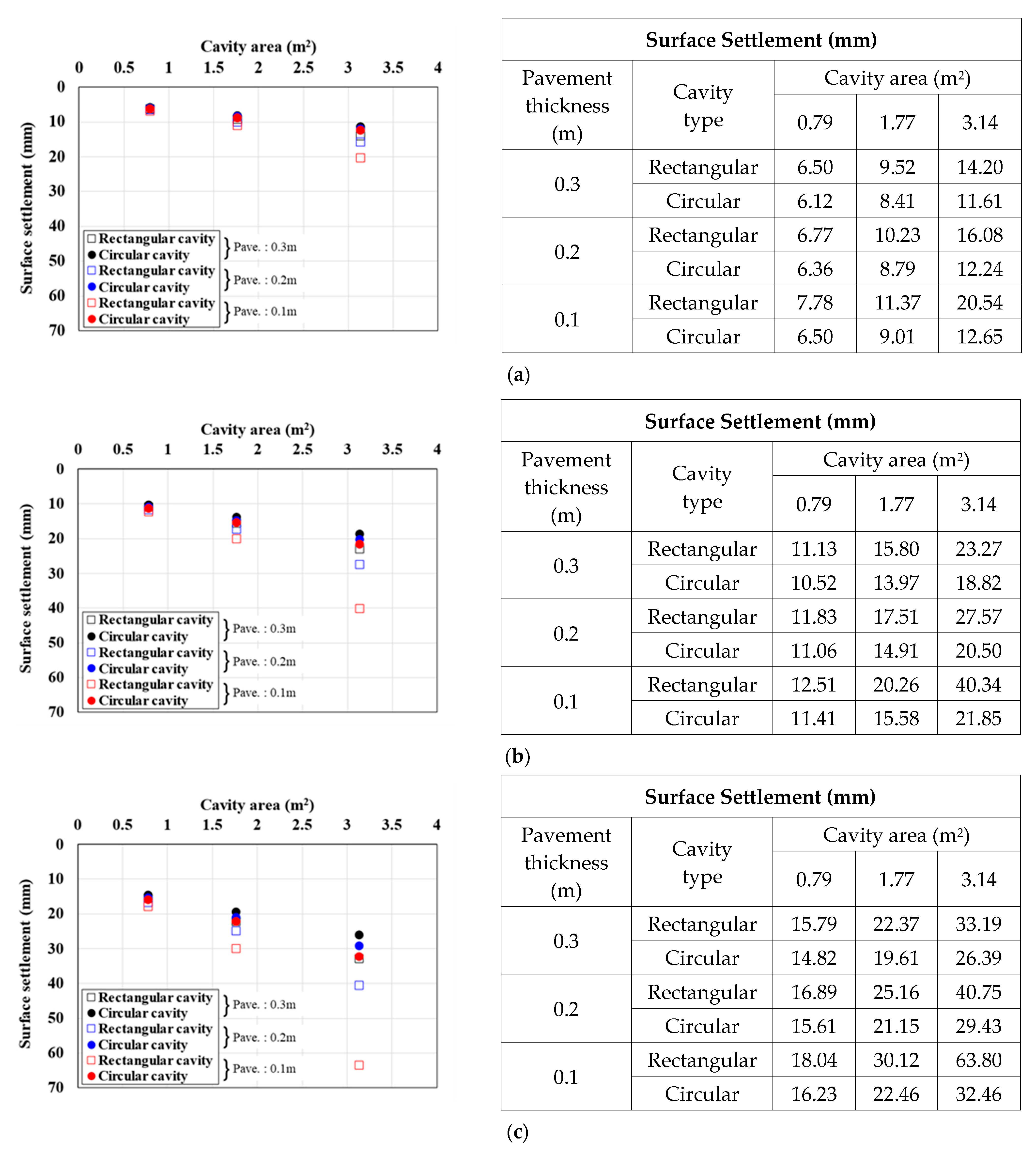



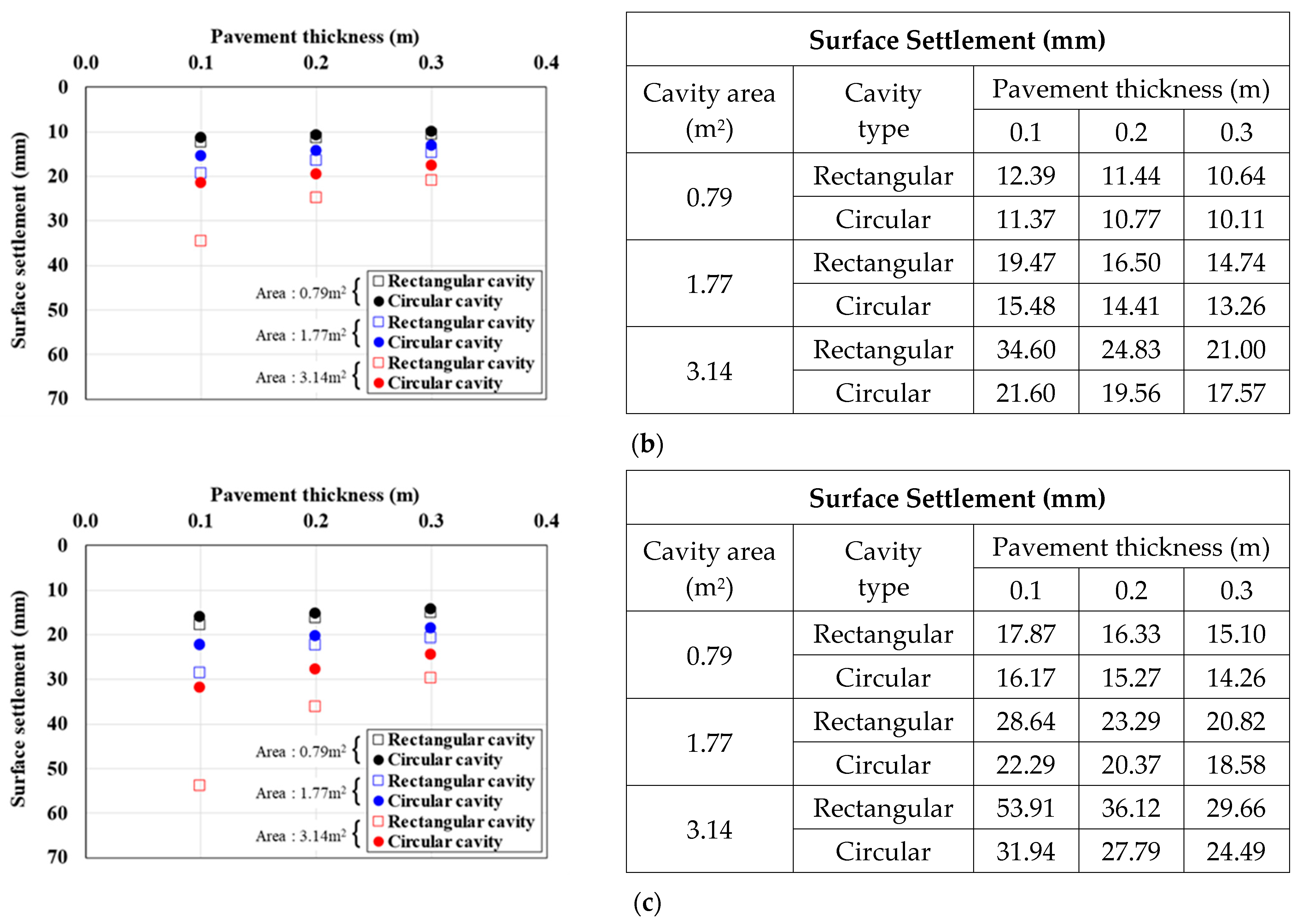
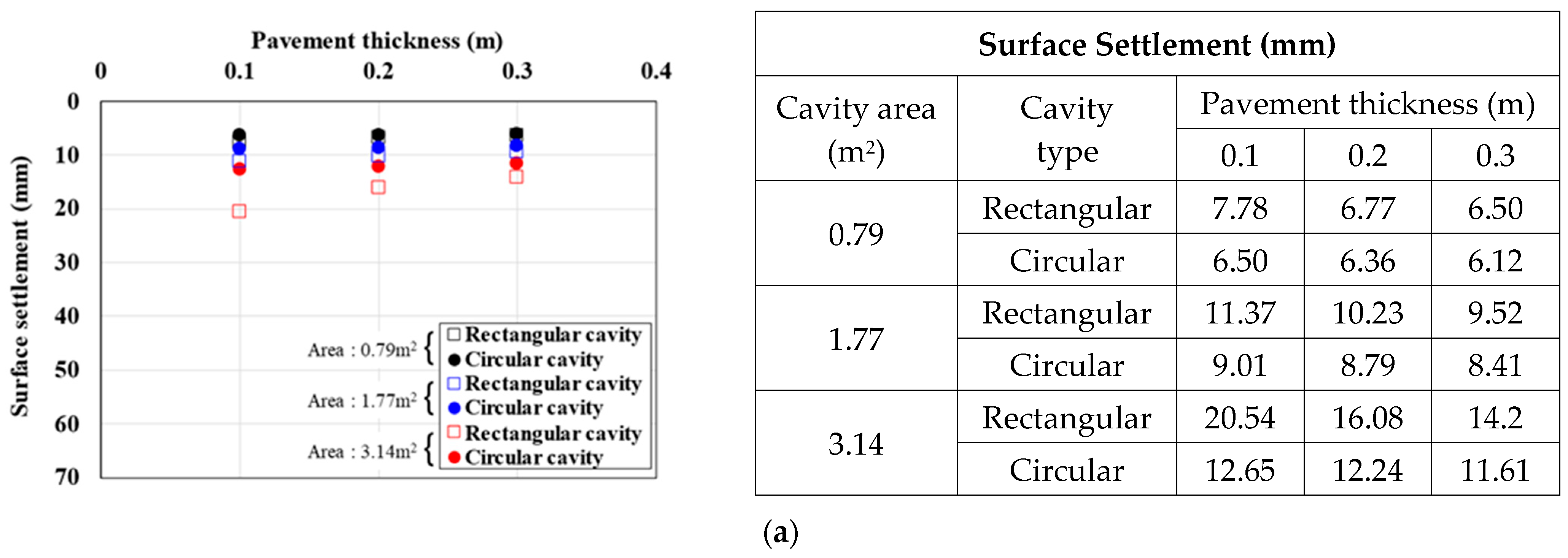
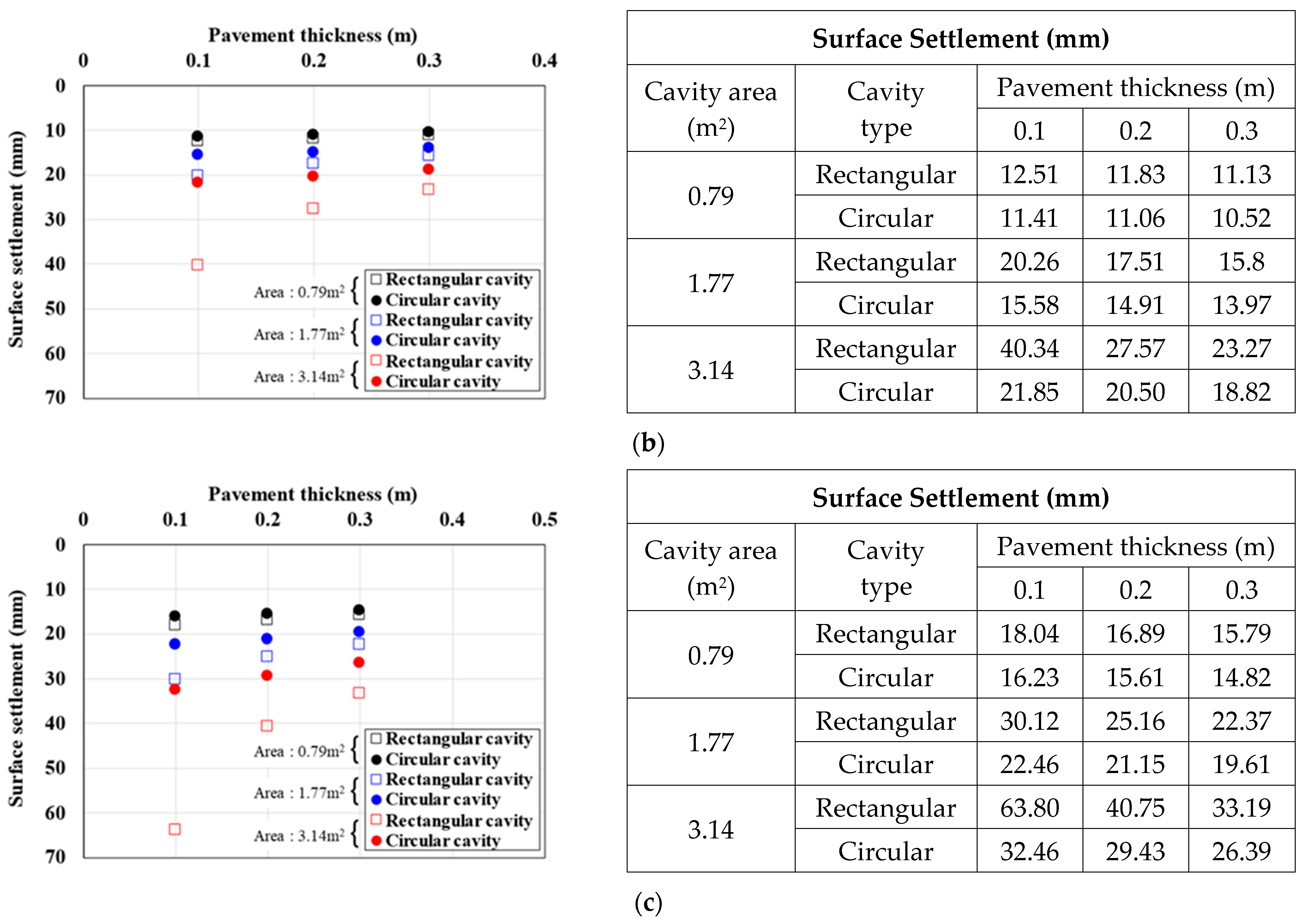
(kN/m3) | ||||||
|---|---|---|---|---|---|---|
| 16,000 | 22,000 | 90,000 | 0.5 | 37 | 1.5 | 18.0 |
| (Mpa) | (kN/m3) | |
|---|---|---|
| 3000 | 0.35 | 24.0 |
| Cavity Type | Cavity Area (m2) | Pavement Thickness (m) | Pavement Elastic Modulus (MPa) | Traffic Load (kN/m2) |
|---|---|---|---|---|
| Rectangular & Circular | 0.79 | 0.1, 0.2, 0.3 | 500, 1000, 3000 | 12.7 |
| 25.4 | ||||
| 38.1 | ||||
| 1.77 | 0.1, 0.2, 0.3 | 500, 1000, 3000 | 12.7 | |
| 25.4 | ||||
| 38.1 | ||||
| 3.14 | 0.1, 0.2, 0.3 | 500, 1000, 3000 | 12.7 | |
| 25.4 | ||||
| 38.1 |
Publisher’s Note: MDPI stays neutral with regard to jurisdictional claims in published maps and institutional affiliations. |
© 2022 by the authors. Licensee MDPI, Basel, Switzerland. This article is an open access article distributed under the terms and conditions of the Creative Commons Attribution (CC BY) license (https://creativecommons.org/licenses/by/4.0/).
Share and Cite
Lee, K.; Nam, J.; Park, J.; Hong, G. Numerical Analysis of Factors Influencing the Ground Surface Settlement above a Cavity. Materials 2022, 15, 8301. https://doi.org/10.3390/ma15238301
Lee K, Nam J, Park J, Hong G. Numerical Analysis of Factors Influencing the Ground Surface Settlement above a Cavity. Materials. 2022; 15(23):8301. https://doi.org/10.3390/ma15238301
Chicago/Turabian StyleLee, Kangil, Junhee Nam, Jeongjun Park, and Gigwon Hong. 2022. "Numerical Analysis of Factors Influencing the Ground Surface Settlement above a Cavity" Materials 15, no. 23: 8301. https://doi.org/10.3390/ma15238301
APA StyleLee, K., Nam, J., Park, J., & Hong, G. (2022). Numerical Analysis of Factors Influencing the Ground Surface Settlement above a Cavity. Materials, 15(23), 8301. https://doi.org/10.3390/ma15238301







